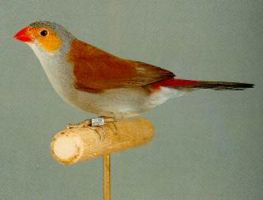CHEEKS ORANGE
Estrilda melpoda Estrildidae

This species of astrildide comes regularly, and in large quantit imported in Europe. In cattivit the exemplary they are perennially in motion and they are demonstrated much sociable, tolerating a lot gladly qualsia similar of imprisonment. In cage the cheeks orange one much decorative species; if if it wants some to obtain the reproduction however necessary to accommodate the brace in one voliera from apartment or sufficiently wide garden and abundant supply cespugliosa vegetation.
In means to this the cheeks orange construct a camouflaged, round nest very, with a lateral entrance. The construction comes realized to the feet of a bush, directly on the land, or in means to the leaves but always rather low.
advisable to arrange a shelter above the nest, without to disturb the birds, so that in case of maltempo the rain it does not damage the brooded one. The female places from 3 to 7 small eggs that brood alone for 11 0 12 days.
After schiusa the a lot important to supply to the parents one sufficient quantit of bugs. In a great rich external voliera of bushes and shrubs the cheeks orange succeed to capture one sufficient quantit of insettucci; in contrary case it must put to they disposition fresh eggs of ant, small tarme of the flour, bugs as soon as captured, etc.
SUGGESTED BREEDINGS by MENANDPETS.COM
No breeding to signal
if you want to know like signaling yours, contacts: marketing@inseparabile.it
To outside of the riproduttivo period the feeding of this species it must be constituted from various variet of mile, panic in ears, scagliola, mixture of seeds for exotic, risen every animal food all.uovo and of verdura. The condition essential for the resolution dell.breeders of the small astrildidi an abundant and varied somministrazione of alimony of animal origin. The small abandon the nest to 22 days of ET and the parents still feed them for approximately 14 days. The young people complete the piumaggio all.et of six weeks. Some breeders, when the climatic conditions are favorable, open the voliera to the cheek braces orange that have the small in the nest in order to concur with the adults to capture bugs in the outskirtses. The exemplary of this species must svernare to not inferior temperatures to the 10.